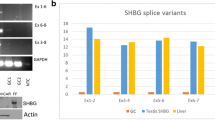Abstract
A variety of hypophysiotropic peptides or proteins have been reported to be present in mammalian gonads. Inhibin, a hormone that under most circumstances selectively suppresses the secretion of follicle-stimulating hormone (FSH) but not luteinizing hormone (LH), has been isolated from the gonadal fluids of several species1–5 and characterized as a heterodimeric protein consisting of α- and β-polypeptides associated by disulphide bonds. The complete amino-acid sequences of the precursors of porcine6,7 and human7 inhibin α-subunits and two distinct porcine inhibin β-subunits (βA and βB)6 have been deduced from complementary DNA sequences. Gonadotropin releasing peptides have also been found in the gonad and have generally been shown to be active in radioreceptor assays for gonadotropin releasing hormone (GnRH) but to exhibit different chromatographic and immunological characteristics from those of GnRH8–14. During our purification of inhibin from porcine follicular fluid, we noted fractions that could stimulate the secretion of FSH by cultured anterior pituitary cells3. We report here the purification of an FSH releasing protein (FRP) and its characterization by SDS-polyacrylamide gel electrophoresis under non-reducing and reducing conditions and by partial sequence analysis. Our results indicate that porcine gonadal FRP is a homodimer consisting of two inhibin βA-chains linked by disulphide bonds. FRP is highly potent (50% effective concentration (EC50)∼25 pM) in stimulating the secretion and biosynthesis of FSH but not of LH or any other pituitary hormone. In contrast to the effects of GnRH and other reported gonadal gonadotropin releasing fractions, the action of FRP is not mediated by GnRH receptors.
Similar content being viewed by others
References
Robertson, D. M. et al. Biochem. biophys. Res. Commun. 126, 220–226 (1985).
Miyamoto, K. et al. Biochem. biophys. Res. Commun. 129, 396–403 (1985).
Rivier, J., Spiess, J., McClintock, R., Vaughan, J. & Vale, W. Biochem. biophys. Res. Commun. 133, 120–127 (1985).
Ling, N. et al. Proc. natn. Acad. Sci. U.S.A. 82, 7217–7221 (1985).
Robertson, D. M. et al. Molec. cell. Endocr. 44, 271–277 (1986).
Mason, A. J. et al. Nature 318, 659–663 (1985).
Mayo, K. et al. Proc. natn. Acad. Sci. U.S.A. (in the press).
Bhasin, S., Heber, D., Peterson, M. & Swerdloff, R. Endocrinology 112, 1144–1146 (1983).
Dutlow, C. M. & Millar, R. P. Biochem. biophys. Res. Commun. 101, 486–494 (1981).
Paull, W. K., Turkelson, C. M., Thomas, C. R. & Arimura, A. Science 213, 1263–1264 (1981).
Sharpe, R. M. Biol. Reprod. 30, 29–49 (1984).
Sharpe, R. M. & Fraser, H. M. Nature 287, 642–643 (1980).
Aten, R. F., Wolin, D. L. & Behrman, H. R. Endocrinology 118, 961–967 (1983).
Ying, S.-Y., Ling, N., Bohlen, P. & Guillemin, R. Endocrinology 108, 1206–1213 (1981).
Vale, W., Grant, G., Amoss, M., Blackwell, R. & Guillemin, R. Endocrinology 91, 562–572 (1972).
Derynek, R. et al. Nature 316, 701–705 (1985).
Mizunauma, H. et al. Brain Res. Bull. 10, 623–629 (1984).
Igarashi, M. & McCann, S. M. Endocrinology 74, 446–452 (1964).
Igarashi, M., Taya, K. & Ishikawa, J. in Psychoneuro-endocrinology (ed. Hatotani, N.) 178–186 (Karger, Basel, 1973).
Dhariwal, A. P. S., Watanabe, S., Antunes-Rodrigues, J. & McCann, S. M. Neuro-endocrinology 2, 294–303 (1967).
Schally, A. V. et al. Endocrinology 98, 380–391 (1976).
Spiess, J. in New and Improved Methods in Protein Microsequence Analysis (eds Wittmann-Liebold, B., Salnikow, J. & Erdmann, V. A.) (Springer, New York, in the press).
Spiess, J., Villareal, J. & Vale, W. Biochemistry 20, 1982–1988 (1981).
Spiess, J., Rivier, J. & Vale, W. Biochemistry 22, 4341–4346 (1983).
Author information
Authors and Affiliations
Rights and permissions
About this article
Cite this article
Vale, W., Rivier, J., Vaughan, J. et al. Purification and characterization of an FSH releasing protein from porcine ovarian follicular fluid. Nature 321, 776–779 (1986). https://doi.org/10.1038/321776a0
Received:
Accepted:
Issue Date:
DOI: https://doi.org/10.1038/321776a0
- Springer Nature Limited
This article is cited by
-
Fibronectin mediates activin A-promoted human trophoblast migration and acquisition of endothelial-like phenotype
Cell Communication and Signaling (2024)
-
Adiponectin, the adiponectin paradox, and Alzheimer’s Disease: Is this association biologically plausible?
Metabolic Brain Disease (2023)
-
Diabetes as a potential compounding factor in COVID-19-mediated male subfertility
Cell & Bioscience (2022)
-
Metformin suppresses the growth of colorectal cancer by targeting INHBA to inhibit TGF-β/PI3K/AKT signaling transduction
Cell Death & Disease (2022)
-
Insights into in vivo follicle formation: a review of in vitro systems
Histochemistry and Cell Biology (2022)





